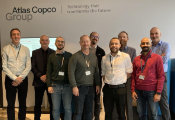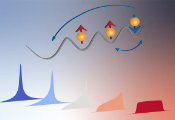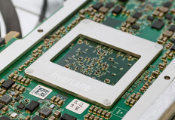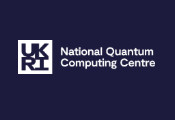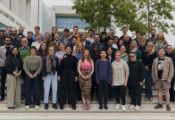QSA Drives Breakthroughs With Superconducting Qubits
May 02 2025 -- Interdisciplinary teams across the Quantum Systems Accelerator (QSA) are using innovative approaches to push the boundaries of superconducting qubit technology, bridging the gap between today’s NISQ (Noisy Intermediate-Scale Quantum) systems and future fault-tolerant systems capable of impactful science applications. QSA is one of the five United States Department of Energy National Quantum Information Science (QIS) Research Centers, bringing together leading pioneers in quantum information science (QIS) and engineering across 15 partner institutions.
A superconducting qubit is made from superconducting materials such as aluminum or niobium, which exhibit quantum effects when cooled to very low temperatures (typically around 20 millikelvins, or -273.13°C). Numerous technology companies and research teams across universities and national laboratories are leveraging superconducting qubits for prototype scientific computing in this rapidly growing field. However, many challenges in controlling, calibrating, and operating superconducting quantum processors currently hinder qubit performance and restrict the kinds of simulations possible, particularly for investigating complex material systems.
Advancing Quantum Simulation
The QSA teams at the Massachusetts Institute of Technology and MIT Lincoln Laboratory simulated how charged particles behave under synthetic electromagnetic fields using superconducting qubits. Publishing their results in the Fall of 2024 in Nature Physics, the team developed a two-dimensional array of 16 superconducting transmon qubits arranged in a 4 x 4 grid. They modified the qubits’ properties with continuous signals using independent electrical control lines for each qubit. The resulting behavior of the qubit grid emulates a magnetic vector potential, a key concept in electromagnetism that impacts how charged particles move in materials.
The team validated their approach to generating synthetic electromagnetic fields by observing the Hall effect, where a charged particle deflects sideways as it moves through a material under a perpendicular magnetic field. In real materials, the Hall effect leads to a voltage across the material, so their experiment demonstrated how precise control and engineering expand the capabilities of quantum simulators.
Expanding on their previous work leveraging the programmability of superconducting qubit arrays, the QSA teams at MIT and MIT Lincoln Laboratory devised another unique approach to studying particle behavior and localization. They selected ten qubits from the 4×4 grid to form a one-dimensional rhombic lattice. This qubit configuration enabled researchers to flexibly manipulate particle transport and group velocity, shedding light on complex phenomena in condensed matter physics. The results were published in arXiv in 2024.
The team was able to tweak this lattice using the synthetic electromagnetic field. Without the field, particles move freely (dispersive band regime), but when the magnetic field increases, the particles slow down and eventually get stuck in the lattice (flat-band regime). The introduction of disorder (random energy variations) is also used to study the distinctive transport responses arising from the adjustably flat band structure.
“Our study demonstrates that adding new capabilities to quantum simulators—like electromagnetic fields—allows us to study impactful physical systems—like materials with flat band structures. These techniques are readily extensible to larger lattices, where we can study exotic quantum phases predicted by condensed matter physics theories,” added Rosen.
Pioneering Control Systems
As programmable superconducting qubit platforms advance fundamental research, there is a growing need in the field for robust control systems. Researchers need to control and direct quantum information systems, performing real-time qubit measurements. A QSA team at Lawrence Berkeley National Laboratory (Berkeley Lab) built a modular field-programmable gate array (FPGA)-based electronics control system called “QubiC 2.0” (and its predecessor “QubiC”).
QubiC 2.0 is uniquely tailored for superconducting quantum systems and is fully open-source, making it available to the broader community. It operates with room-temperature electronics hardware, FPGA gateware, and engineering software to realize the desired radio frequency pulses to control and measure qubits. The fully open-sourced QubiC 2.0 gateware also provides an exquisite low-level access to researchers to all control layers, enabling others to participate in the product’s evolution and provide feedback.
Assessing Performance
Another example of novel approaches using superconducting qubits was led by a team of researchers at the University of California, Berkeley, in collaboration with Berkeley Lab and Sandia National Laboratories. Researchers introduced a new technique to assess the performance of quantum logic gates called mirror randomized benchmarking (MRB), which can scale to thousands of qubits. Many widely used methods, like randomized benchmarking, become impractical beyond a small number of qubits. Their results, published in Physical Review X, demonstrate that the method is highly adaptable, creating a way to study the performance of certain gates or even algorithms without costly computations.
“MRB’s scalability allows it to accurately capture multi-qubit crosstalk errors missed by standard one- and two-qubit benchmarks. These crosstalk errors can be highly detrimental to performance. Our MRB results reveal that they constitute a significant fraction of the error on some of today’s quantum processors,” said lead author Jordan Hines.
QSA teams focusing on superconducting qubit platforms are pushing the boundaries of the nascent quantum technologies and opening new possibilities for advanced computing and the exploration of complex phenomena. From simulating synthetic electromagnetic fields and particle behavior to developing scalable control systems and advanced benchmarking techniques, they’re paving the way for versatile quantum systems. The seamless collaboration across QSA will continue accelerating progress toward fault-tolerant quantum computing and creating new opportunities for exchanging lessons about qubit technologies.





